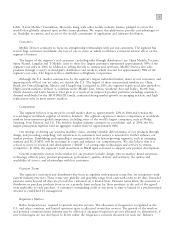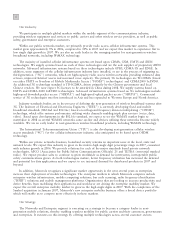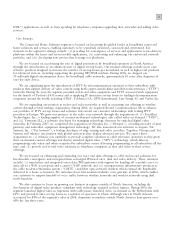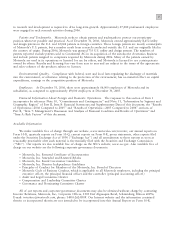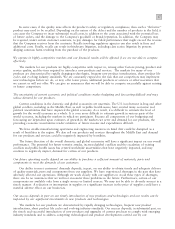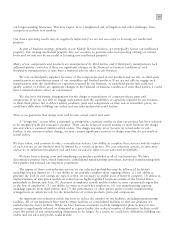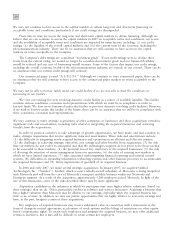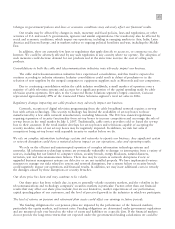Motorola 2006 Annual Report Download - page 21
Download and view the complete annual report
Please find page 21 of the 2006 Motorola annual report below. You can navigate through the pages in the report by either clicking on the pages listed below, or by using the keyword search tool below to find specific information within the annual report.
13
telephone carriers to offer certain services, or the terms on which the companies offer the services and conduct
their business, may affect the segment's results.
Currently, reception of digital television programming from the cable broadband network requires a set-top
box with certain technology. This security technology has limited the availability of set-top boxes to those
manufactured by a few cable network manufacturers, including Motorola. The FCC has enacted regulations
requiring separation of security functionality from set-top boxes to increase competition and encourage the sale of
set-top boxes in the retail market by July 1, 2007. Traditionally, cable service providers sold or leased the set-top
box to their customer. As the retail market develops for set-top boxes and televisions capable of accepting the
security modules, sales of our set-top boxes may be negatively impacted. In addition, we risk lost sales if
competitors bring set-top boxes with separable security to market before we do.
Backlog
The segment's backlog was $792 million at December 31, 2006, compared to $430 million at December 31,
2005. The increase in backlog and related orders primarily reflects increased orders from our customers for digital
and HD/DVR set-top boxes. The 2006 order backlog is believed to be generally firm and 100% of that amount is
expected to be recognized as revenue in 2007. The forward-looking estimates of the firmness of such orders is
subject to future events, which may cause the amount recognized to change.
Intellectual Property Matters
We seek to build upon our core enabling technologies, such as digital compression, encryption and conditional
access systems, in order to lead worldwide growth in the market for broadband communications networks. Our
policy is to protect our proprietary position by, among other methods, filing U.S. and foreign patent applications to
protect technology and improvements that we consider important to the development of our business. We also rely
on our proprietary knowledge and ongoing technological innovation to develop and maintain our competitive
position, and will periodically seek to include our proprietary technologies in certain patent pools that support the
implementation of standards. We were a founder of MPEG LA, the patent licensing authority established to foster
broad deployment of MPEG-2 compliant systems. We have also licensed our digital conditional access technology,
DigiCipher(R) II, to other equipment suppliers and have formed joint ventures with Comcast for development and
licensing of conditional access technology. We also enter into other license agreements, both as licensor and
licensee, covering certain products and processes with various companies. These license agreements require the
payment of certain royalties that are not expected to be material to the segment's financial results.
Inventory, Raw Materials, Right of Return and Seasonality
The segment's practice is to carry reasonable amounts of inventory in order to meet customer delivery
requirements in a manner consistent with industry standards. At the end of 2006, the segment had higher inventory
balances than at the end of 2005 due to the timing of transitions to EMS manufacturers and business acquisitions.
Availability of materials and components required by the segment is relatively dependable, but fluctuations in
supply and market demand could cause selective shortages and affect results. We currently source certain materials
and components from single vendors. Any material disruption from a single-source vendor may have a material
adverse impact on our results of operations.
Electricity is the primary source of energy required for our manufacturing operations, which is currently in
generally adequate supply for the segments operations. In addition, the cost to operate our facilities and freight
costs are dependent on world oil prices. A substantial increase in world-wide oil prices could have a negative
impact on our results of operations. Labor is generally available in reasonable proximity to the segment's
manufacturing facilities. However, difficulties in obtaining any of the aforementioned items or a significant cost
increase could affect the segment's results.
Generally, we do not permit customers to return products, other than for standard warranty provisions. We
have not recently experienced seasonal buying patterns for our products. However, as our retail cable modem and
digital set-top box sales increase, we may have increased sales during the holiday season at the end of each year.


